
October 1
| 1896 | The first experimental routes for the rural free delivery of mail are established from Charles Town (home of Postmaster General William Wilson), Halltown, and Uvilla, WV. As the experiment expands, it becomes one of the most effective means of persuading farmers of the need for good roads. |
| 1911 | The Washington Herald announces a "bombshell to the automobilists of this city." Director Logan Page denounced Arthur Jackson, President of the National Good Roads Association, after the latter's announcement of a campaign to raise $1 million for good roads. "His plan," Page says, "is intended to benefit no one but himself, and the funds are to go to no one but himself." Post-office inspectors are already on Jackson's trail "and are making determined efforts to run him down." |
| 1962 | "David Brinkley's Journal" on NBC-TV includes an interview with Administrator Rex Whitton in a highly critical report on allegations of corruption in the highway program. The program prompts rebuttals by Members of Congress, the highway community, and Whitton. An ARBA petition to the FCC requests an investigation of the "vicious attack on the integrity of highway officials and the highway industry." In a letter to NBC, AASHO defends Whitton as "a Christian gentleman, a fine engineer, and a very effective Administrator." It adds that, "He is not an effective public speaker, especially when having to field loaded surprise questions." |
| 1964 | Lawrence Jones is sworn in as the second Deputy Administrator (not counting Acting Deputy Administrator Lowell Bridwell). A lawyer, Jones had practiced law in Texas and served as Assistant Attorney General of Texas, General Counsel of the Maritime Administration, and the USDOT's Deputy General Counsel. |
| 1998 | Administrator Kenneth Wykle begins phase one of FHWA restructuring. The first phase, which involves asking employees to identify their interest in a lateral reassignment, ends on December 14. As of that date, 231 employees had accepted laterals. Later phases included restructuring of headquarters into five core business units and eight cross-cutting service units (February 1999), advertising vacant positions (February 1999), and completing headquarters shifts (by July 1, 1999). |
October 2
| 1946 | Restrictions on highway construction with Federal funds, imposed on August 5, 1946, by the Director of War Mobilization and Reconversion to avoid conflict with the post World War II housing program, are lifted except for projects requiring structural steel. |
| 1969 | Regional Federal Highway Administrator John A. Hanson, who joined BPR in 1949, is killed in a car accident a block from his Albany, NY, office. Deputy Director E. H. Swick represents Administrator Frank Turner at the funeral. An annual award, given for outstanding performance in the transportation field in Region 1, is named for Hanson. |
| 1976 | Secretary of Transportation William Coleman, Jr., holds a public hearing to receive arguments on proposed I-66 between the Capital Beltway and Washington, DC. The hearing, held in the Departmental Auditorium in Washington, DC, provides the Secretary with an opportunity to hear arguments on whether he should approve construction of I-66 as a four-lane highway. (See January 5, 1977.) Following a public hearing on June 21, 1975, Secretary Coleman had rejected the State's six-lane proposal. |
| 1993 | Administrator Rodney Slater is keynote speaker at the opening of the Isle of Palms Connector in South Carolina. The project, built in part with emergency relief funds made available following the devastation caused by Hurricane Hugo in 1989, is hailed for environmental sensitivity in minimizing damage to delicate salt marshes.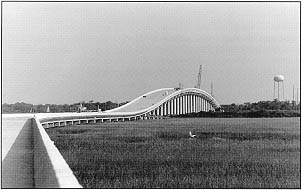
|
| 2001 | Mary E. Peters, former Director of the Arizona Department of Transportation (1998-2001), takes the oath of office as the 15th Federal Highway Administrator. The first woman to hold the title, she remains in the post until July 30, 2005. On September 5, 2006, President George W. Bush would nominate her to be Secretary of Transportation, saying that as Administrator, "Mary led efforts to improve safety and security, reduce traffic congestion, and modernize America's roads and bridges." (See October 17, 2006.) |
October 3
| 1893 | Agriculture Secretary J. Sterling Morton establishes ORI, the first Federal road Agency, in two small attic rooms of the main Agriculture Building. The Agency consists of General Roy Stone, Special Agent and Engineer for Road Inquiry, and Robert Grubbs, stenographer. Its budget is $10,000. Largely a response to lobbying by bicycle enthusiasts for better roads, ORI is given a mission of making inquiries on systems of road management, investigating the best methods of road making, preparing didactic publications, and assisting the agricultural colleges and experiment stations in disseminating information on this subject.
"It must be borne in mind that the actual expense in the construction of these highways is to be borne by the localities and States in which they lie." 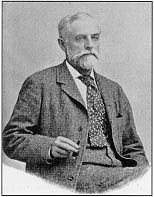
Special Agent and Engineer for Road Inquiry |
| 1970 | Ribbon-cutting ceremonies open a 77-mile section of I-80 between Laramie and Walcott, WY, the longest stretch of Interstate to open at one time with no portion of the entire length previously open. Deputy Administrator Ralph Bartelsmeyer participates. (The second longest stretch had opened on October 14, 1962, a 65-mile stretch of I-90 between Buffalo and Gillette, WY.) |
October 4
| 1910 | Director Logan Page addresses the Southern Appalachian Good Roads Association on "To What Extent Do Automobiles Destroy Our Roads." He comments, "The application of mechanical arts to our daily convenience and comfort necessarily introduces new problems which require long and patient experimenting for their solution, but when solved, are apt to produce a betterment of conditions that might otherwise not have been reached." The problem, he adds, does not involve paved roads in cities. "But, in the open country, where we have the grinding action of the iron tire and heavy load followed by the high-speed automobile throwing up and distributing the product of wear, we are confronted with the necessity of providing new and more durable forms of road."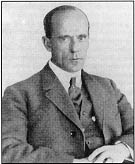
Director Bureau of Public Roads |
| 1957 | BPR awards a $500,000 contract for construction of the Wind River Bridge, a Forest Highway project to provide a high-level span across Wind River Canyon near Carson, WA. The new bridge will replace a low-level crossing, built in 1924, that has been load-restricted to 10 tons in recent years. |
October 5
| 1958 | The First National Congress on Highways and Urban Development convenes at Sagamore, Syracuse University, in New York, partly to recoup from adverse publicity during the Hartford Conference. (See September 9, 1957.) With Pyke Johnson of the Automotive Safety Foundation as Chair, the conference brings 55 key highway and transit officials, planners, elected officials, as well as business and academic leaders for a full week of living, eating, and working in the total isolation of the Adirondack Mountains. Participants are asked three questions: What do we want? Who is responsible and for what? and How do we get the job done? The conference results in a widely distributed and acclaimed Guidelines for Action, published by the foundation. |
| 1959 | In Denver, CO, before the Governors' Conference Committee on Roads and Highway Safety, Senator Albert Gore, Sr., of Tennessee, describes some of the problems confronting the Interstate Highway Program, including proposals to drastically curtail the program's scope. "The highway program is now in grave danger."
"I am convinced that better highways are essential both for a growing economy and for national defense. The programs outlined in the Acts of 1956 and 1958 are the very minimum necessary to meet the needs of the nation. If we allow this program to be curtailed, stretched out and weakened at this point, we cannot hope to have a Highway System commensurate with our needs within the foreseeable future." 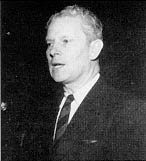
|
October 6
| 1910 | OPR's Maurice O. Eldridge addresses the Second Annual Convention of the Southern Appalachian Good Roads Association in Knoxville, TN, on "Road Laws and Road Building." As a Tennessee native, he recalls his boyhood days when, under the "statute labor" system, citizens paid their road tax by working on the roads. "We used to turn out in the fall of the year, in September or October, when the roads were hard and dry, and pile up clods, sods and vegetable mold in the middle of the road. If there were any mudholes we would usually haul large stones from adjacent fields and fill them, and that would usually make two mudholes, which were filled in the same way the following year." |
| 1926 | Chief Thomas MacDonald presents a paper to the Annual Convention of the American Society of Civil Engineers on "The History and Development of Road Building in the United States" (written with H. S. Fairbank) that becomes a standard reference for historians.
"There is but one limit which may reasonably be set. It is this: No road should be improved by expenditures of public funds in excess of its earning capacity. The return to the public in the form of economic transportation is the sole measure and justification of the degree of highway improvement." |
| 1970 | Administrator Frank Turner speaks on "Urban Growth and Mobility in the United States," at the Sixth World Highway Conference in Montreal. He says that deciding the role of each transportation mode is an issue of public policy. "The question is not so much one of choosing between competing modes as it is one of providing an effective mix of complementary modes." |
| 1977 | In Portland, OR, Administrator William Cox tells the Northwest Bridge Engineers Seminar that highway transportation would predominate over all other transportation modes for the foreseeable future. "Consequently, we have to correct problems with highway bridges immediately." He adds, however, that the size of the bridge program "must be based on a realistic assessment of what can actually be accomplished." |
| 1981 | At AASHTO's annual meeting in Chicago, Executive Director Les P. Lamm receives the annual Thomas H. MacDonald Award for continuous outstanding service. |
| 1993 | The last precast segment of the Double Arch Bridge of the Natchez Trace Parkway is placed, completing the 1,572-foot long superstructure. The bridge, designed by Figg Engineering Group for FHWA's Eastern Federal Lands Highway Division, is the first segmental precast concrete arch bridge in this country. |
October 7
| 1905 | OPR completes work on an object lesson road on the grounds of the U.S. Weather Bureau in Mount Weather, VA (begun July 19). The macadam road uses hornblende schist procured near the road. Concrete curbs were constructed on both sides of the road, with suitable paved gutters, catch basins, and cross drains. The road is 2,047 feet long, with a width varying from 15 to 18 feet and a total depth after rolling of 6 inches. The cost of this road is $2,629.81, not including the curbs, catch basins, or brick-paved gutters. The cost per day of labor was $1.50 and of teams, $3.50. |
October 8
| 1922 | "Seven Days for Safety" get underway (October 8-14). At their end, Chief Thomas MacDonald says accidents "can be reduced to a minimum only by a combination of careful driving and the elimination of dangerous grades and curves, narrow roadways and bridges and the deadly grade crossing . . . . The dangerous conditions at these points must be eliminated and each state highway department should have data available so that the elimination of the most dangerous ones can be undertaken first." |
| 1924 | The Civil Service Commission holds exams nationwide for positions with BPR as junior engineer ($2,400 a year if assigned to Washington, DC; $1,500-$2,000, if not). Applicants must have graduated with a degree in engineering from a college of recognized standing or must be within 3 months of graduation. Competitors will be rated on general physics, pure and applied mathematics, practical questions on highway engineering, as well as education, training, and experience. |
| 1974 | Administrator Norbert Tiemann announces that FHWA will emphasize a Low Capital Transportation Improvements Program to focus on projects that will provide maximum use of existing facilities. |
| 1989 | In a ceremony at AASHTO's Annual Meeting in Atlanta, GA, Administrator Thomas Larson presents FHWA's first "Innovative Financing" awards to eight organizations for their outstanding work in finding innovative ways to finance highway construction and services. |
October 9
| 1939 | To celebrate AASHO's 25th anniversary, some 500 members have breakfast at Washington, DC's Raleigh Hotel, site of the association's founding. (See December 12, 1914.) In the day's highlight, AASHO President W. W. Mack presents Certificates of Appreciation to the 15 surviving founders, 9 of whom are present. J. E. Pennybacker, Jr., the only surviving founder from OPR, is present to receive his certificate. "As president of the Association," Mack says, "no happier privilege comes to me than that of presenting these certificates to the men who made highway history here 25 years ago." |
| 1961 | Parade magazine notifies the Maine State Highway Commission that a 24-mile section of I-95 (Augusta to Waterville and Fairfield) has been chosen America's finest new scenic highway in the magazine's first competition. An article in the October 15 issue comments that the State thought "the interstate route in tourist-conscious Maine should be a delight to drive along, as well as an efficient conveyor."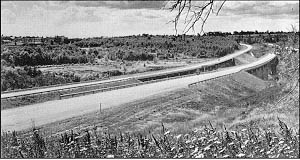
|
| 1967 | Administrator Lowell Bridwell announces that a 7-week study has confirmed the safety benefits of shoulder belts used in combination with seat belts. |
October 10
| 1898 | The National Road Parliament is held under OPRI's auspices in connection with the Trans-Mississippi Exposition in Omaha, NE. Director Martin Dodge demonstrates the advantages of steel track wagon roads by moving an 11-ton load (consisting of delegates) with one horse--instead of the usual 20. Dodge considers the parliament a success because most of the western States were represented, "something which had not heretofore occurred in meetings of this sort." He added that "the delegates who attended were the representative and enthusiastic road workers of their respective communities and States."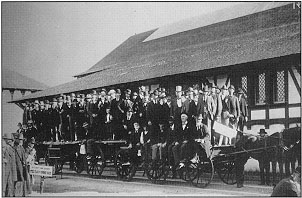
|
| 1957 | Representatives of State highway agencies, auto manufacturers, and BPR observe the first U.S. demonstration of an electronic traffic control system activated by vehicles passing over the highway. The demonstration is sponsored by RCA and the Nebraska Department of Roads and Irrigation on U.S. 77 near Lincoln, NE. |
October 11
| 1902 | In Seattle, WA, Director Martin Dodge writes to Secretary of Agriculture James Wilson about the progress of the Great Northern Good Roads Train, which was organized by the National Good Roads Association, President J. J. Hill of the Great Northern Railroad, OPRI, and manufacturers of roadmaking machinery. The trip had begun on September 1 at St. Paul, MN, with a 3-day convention of the Minnesota Good Roads Association, and had been scheduled to travel west all the way to the Coast. However, the train was discontinued after completing a stop on September 21 in Grand Fork, ND, because farmers were especially busy at this time of year, and it had been impossible to secure the desired attendance. Dodge and James W. Abbott, OPRI's Special Agent for the Rocky Mountain and Pacific Coast States, continued west with other participants (by regular trains) to attend previously scheduled conventions. Writing to Secretary Wilson, Dodge encloses "a large number of newspaper clippings, which contain an abridged report of the work that we have done with the good roads train in the Northwest and of the manner in which it was received."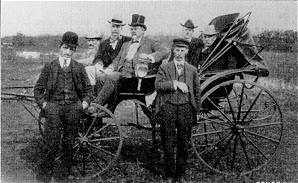
|
| 1930 | PIARC's Sixth International Road Congress concludes in Washington, DC, the first to be held in the United States. In an opening statement on October 6, Secretary of State Henry L. Stimson thanked delegates for "bringing to us the results of the best thought and experience of your respective countries in the important problems involved in improved communication through road construction." |
October 12
| 1908 | Director Logan Page heads the United States delegation to the First International Road Congress, held in Paris, France. On October 15, he joins with the German, Italian, and Russian delegates to propose a permanent international organization, which became PIARC. |
| 1956 | Secretary of Commerce Sinclair Weeks announces that President Dwight D. Eisenhower's choice for BPR Administrator is Bertram D. Tallamy and that John Volpe will serve as Administrator in the interim. Upon being sworn in on October 22, Volpe becomes the first Federal Highway Administrator and the President says that after working a long time on the Interstate program, he is "anxious for it to move into high gear." Tallamy, when he takes office on February 5, 1957, is the first Administrator confirmed by the Senate.
|
| 1959 | At AASHO's annual meeting in Boston, MA, Missouri's Chief Engineer, Rex Whitton, presents the Thomas H. MacDonald Award to AASHO Executive Secretary A. E. Johnson, formerly a highway official in Arkansas.
"I remember back in 1943 a conference with Mr. MacDonald [who] was telling me all about the big urban problem we were going to have in highway transportation . . . . Down at Little Rock we didn't know much about that . . . but I was very patient with him and listened. I didn't want to hurt his feelings. But I can look back and see the foresight and vision he had." |
| 1962 | BPR participates in opening ceremonies for the Thatcher Ferry Bridge over the southern end of the Panama Canal. Regional Engineer Ralph P. Agnew, Regional Bridge Engineer R. Zuniga, and Panama Division Engineer H. L. Friel represent BPR. |
| 1964 | James W. Jennings, Jr., totally blind since 1945, reports for duty as a highway engineer in the Structures and Applied Mechanics Division, Office of Research and Development. |
| 1977 | FHWA issues national standards for permitting right-turns-on-red at traffic-signal controlled intersections on the Nation's highways and streets. The new standards provide for right-turns-on-red except when engineering studies dictate otherwise. Only two States (Connecticut and Massachusetts) and the District of Columbia prohibit the turns. |
October 13
| 1949 | The Engineering News-Record dated today includes an article on "Subsurface Road Conditions Revealed by Geophysical Methods" by BPR's F. W. Cron and R. Woodward Moore. "The science of geophysics," the article begins, "has provided the engineer and contractor with two new and extremely useful methods for exploring the subsurface. These are the refraction seismic test and the earth resistivity test." The techniques were developed for exploration at depths of hundreds of feet below the surface, but BPR adapted them so they can be used for construction of highways, dams, buildings, and other structures. The article describes how geophysical methods were used on a project to relocate Fighting Creek Gap Road in Great Smoky Mountains National Park. Although used primarily to gain information for design, the techniques helped demonstrate how geophysical tests previously used only by research personnel could be applied in the field. The Physical Research Branch provided the equipment, and an engineer, but all other personnel came from the Division of Eastern Park and Forest Roads at Gatlinburg, TN. |
October 14
| 1992 | Administrator Thomas Larson joins Colorado officials to open I-70 through Glenwood Canyon, CO, completing the Interstate highway from Baltimore, MD, to Cove Fort, UT (2,175 miles). With its hanging viaducts and environmental sensitivity, the final segment of I-70 is instantly declared a world-class scenic byway. Built to minimize environmental damage, the project was complicated because the canyon already carried the Colorado River, a transcontinental railroad track, and U.S. 6. At the Dedication Ceremony, Dr. Larson remarked, "This project proves that desirable environmental goals and great engineering feats can be mutually compatible." |
| 1993 | Administrator Rodney Slater represents the Administration at the opening of the Glenn Anderson Freeway/Transitway (I-105), formerly the Century Freeway, in Los Angeles, CA. The $2.2-billion, 17.3-mile high-tech freeway includes traffic sensors buried in the pavement, computers to monitor flow, meters to regulate traffic on the ramps connecting I-105 to four other freeways, closed-circuit television cameras, and room in the median for the Green Line trolley, slated to open in May 1995. The freeway is named after former U.S. Representative Glenn Anderson, a longtime project supporter and Chairman of the House Committee on Public Works and Transportation. |
| 2010 | Secretary of Transportation Ray LaHood dedicates the Mike O'Callaghan-Pat Tillman Memorial Bridge at Hoover Dam in Nevada. Built by FHWA's Office of Federal Lands Highways, the new bridge is the western hemisphere's longest single-span concrete arch bridge and one of the tallest. The 1,900-foot-long bridge is part of a $240 million four-lane bypass that will reroute traffic for 3.5 miles from the two-lane bottleneck on U.S. 93 across the Hoover Dam. Administrator Victor M. Mendez, who fought for the bypass bridge while Director of the Arizona Department of Transportation, says, "The hard work and dedication of the men and women who worked on this bridge honor the legacy of those who built the Hoover Dam 75 years ago." |
October 15
| 1919 | BPR's FY 1919 annual report, which Chief Thomas MacDonald transmits to Secretary of Agriculture D. F. Houston today, notes that of 189 men employed by BPR at the start of World War I, 79 entered military service (plus one woman, clerk Edna Munger) and 3 died in action (Drainage Engineer Willis E. Comfort, Jr., Highway Engineer Percy A. Rideout, and stenographer Harris E. Petree). In addition, Auditor William Brown died of the nationwide flu epidemic, which struck immediately after the war. One BPR woman entered the naval service as a landsman. |
| 1958 | BPR Commissioner Ellis Armstrong attends the ribbon cutting ceremony for the AASHO Road Test at Ottawa, IL, one of his first official acts as Commissioner. "Today we are opening the most important section of highway in the country. For highways are built for only one reason--to serve the people. And this road is not different in that respect . . . . The benefits from this test road . . . will begin to serve the Nation at the earliest possible date." BPR Director Frank Turner and former Commissioner Charles Curtiss, now with ARBA, also participate.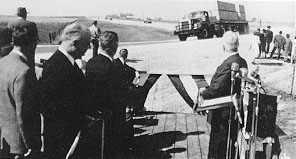
|
| 1966 | President Lyndon Johnson signs the Department of Transportation Act in the East Wing of the White House, authorizing creation of the USDOT, with FHWA as one of the modal Administrations.
"The Department of Transportation will have a mammoth task--to untangle, to coordinate, and to build the national transportation system for America that America is deserving of." |
| 1975 | Administrator Norbert Tiemann announces the establishment of an FHWA Division Office in Tehran, Iran, to be headed by Daniel Hammond and staffed with 11 FHWA employees. FHWA will be reimbursed for all costs incurred while providing technical assistance to Iran. |
| 1990 | President George Bush signs Public Law 101-427, renaming the National System of Interstate and Defense Highways: "The Dwight D. Eisenhower System of Interstate and Defense Highways." |
| 1999 | FHWA's Nondestructive Evaluation Validation Center debuts at the Turner-Fairbank Highway Research Center. The center is the only one in the world dedicated to evaluating and validating nondestructive technologies for highway and bridge inspection. Executive Director Anthony R. Kane joins Research and Development's Associate Administrator Bob Betsold and Glenn Washer in cutting the ceremonial ribbon. |
October 16
| 1893 | In a circular letter to railway managers, General Roy Stone asks for information on the supply of road building materials, accessibility, transportation rates, etc., along the lines of their respective roads. The responses provide information for ORI Bulletins No. 5 (certain States west of the Mississippi River), No. 6 (certain States north of the Ohio River), and No. 7 (certain eastern and southern States). |
| 1921 | Bids are opened for the most difficult portion of the 115-mile McKenzie River Highway between Eugene and Bend, OR. In cooperation with the Forest Service, BPR is responsible for this 15-mile project that consists of reducing the heavy grades approaching the summit of the Cascade Mountains. Much of the work will require heavy work through the timber and, on the upper section over sloping beds of lava, considerable rock excavation.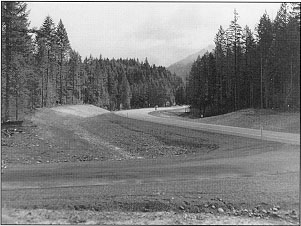
|
| 1958 | A caravan of citizens and North Dakota officials travels to the Eckelson interchange, I-94, to open the State's first fully completed Interstate section (the longest continuous stretch completed since enactment of the Federal-Aid Highway Act of 1956). Mr. Paul Royster, Assistant to the Administrator, addresses participants. |
| 1969 | Secretary of Transportation John Volpe circles Los Angeles in a Coast Guard helicopter to observe the morning rush hour. Later, addressing the Central City Association's 45th Annual Meeting at the Biltmore, he says, "Although Californians love their automobiles, they will have to recognize that we can never provide the mobility they demand and deserve if we restrict ourselves to automobiles alone." |
October 17
| 1973 | In Lebanon, 11 Middle East nations proclaim a progressively increasing monthly cut in exports of oil to the United States and other nations perceived as unfriendly to Arab goals. The cut soon becomes a boycott, touching off the first of two energy crises in the 1970s, this one lasting until the spring. (See January 2, 1974.) |
| 1979 | Administrator Karl Bowers presents 110 paintings by BPR's Carl Rakeman to the Boston Museum of Transportation. The paintings depict scenes from highway history. (See March 31, 1976.) The paintings are also the centerpiece of Historic American Roads: Frontier Trails to Superhighways by BPR's Albert C. Rose (Crown Publishers, Inc., 1976). "The birth and growth of America," Bowers says, "has been and continues to be 'The Greatest Show on Earth,' and the Rakeman paintings tell the story of how that show was put on the road." (The paintings are now at the Rutherford B. Hayes Presidential Center and Museum in Fremont, OH, an organization that Rakeman was closely associated with.) |
| 1989 | The Loma Prieta Earthquake, 7.1 on the Richter scale, causes the double-decked Nimitz Freeway (I-880) in Oakland, CA, to collapse, killing 42, and damages the Embarcadero Freeway, the San Francisco-Oakland Bay Bridge, and other roads in the Bay Area. The death toll is less than at first expected--although the earthquake occurred during evening rush hour, many residents had gone home early to watch the Oakland A's and the San Francisco Giants in the World Series.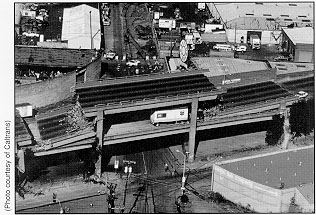
|
| 2006 | Former Administrator Mary E. Peters takes the oath of office as the 15th Secretary of Transportation. She becomes the third Secretary, after John A. Volpe (1969-1972) and Rodney E. Slater (1997-2001), who also served as FHWA Administrator. In an address, the new Secretary refers to DOT employees as "the soul of American Transportation Network" and promises to work with them "to tackle today's most pressing transportation challenges." |
October 18
| 1957 | BPR adds 2,102 miles to the Interstate System, including the 1,000-mile extension from the Federal-Aid Highway Act of 1956 and the 1,102 miles made available from the 40,000 miles authorized in 1944 (by adoption of more direct alignments than the existing highways). State proposals had totalled 13,775 miles. Proposals were considered on a national basis, taking into account national defense needs, system integration, transportation requirements of industry and agriculture, and population service. |
| 1960 | President Dwight D. Eisenhower is the principal guest and speaker at the opening of the Hiawatha Bridge across the Missouri River between Minnesota and Wisconsin at Red Wing. Minnesota Division Engineer and Mrs. W. W. Fryhofer as well as Wisconsin Division Engineer R. H. Paddock represent BPR. The bridge replaces a substandard, load-limited structure.
"The dedication of this fine new bridge across the Mississippi is another effective example of Federal-state partnership in meeting both local and national needs..." |
| 1966 | President Lyndon Johnson issues a directive establishing an Interagency Department of Transportation Task Force to provide for establishment of the USDOT with a minimum of disruption. Chief Engineer Frank Turner represents BPR/FHWA on the task force, but other BPR officials participate in the activities (S. K. Booth, Laurence S. Casazza, W. D. Dillan, James D. Lacy, Thomas F. McGarry, E. J. Martin, S. E. Ridge, and C. H. Smith). |
October 19
| 1910 | H. C. Wells, OPR's Superintendent of Road Construction, addresses the North Carolina State Fair on good roads. "Good roads and civilization go hand in hand. So closely are roads related to the life of the community that they may well be taken as an index of its ethical, financial and industrial condition."
"The prosperity of a community is in direct proportion to the condition of its roads." |
| 1974 | Over 5,000 people gather west of Sidney, NE, for the "Golden Link" ceremony honoring completion of the last segment of I-80 in the State. "It's a vital link," reads a historical marker, "between eastern and western Nebraska; a link that binds our state, culturally and economically, closer together." |
| 1982 | Administrator Ray Barnhart announces selection of 10 State highway agencies, each of which will work with a university to establish a Technology Transfer Center to help local transportation agencies. FHWA will provide $250,000 over a 2-year period to each of the States for their sponsorship of the selected universities. |
| 1993 | A 3-day symposium on "Recovery and Effective Reuse of Discarded Materials and By-Products for Construction of Highway Facilities" opens at the Red Lion Inn in Denver, CO. Sponsored by FHWA and EPA, the symposium includes sessions on recycling domestic and household waste, materials generated by highway construction and maintenance operations, and management of industry by-products. In the keynote address, Executive Director E. Dean Carlson urges the highway industry to work closely with the environmental community to identify and promote innovative and cost effective recycling strategies. |
October 20
| 1892 | In Chicago, IL, over 1,000 people attend the organizational meeting of the National League for Good Roads. General Roy Stone, who issued a call for the congress on September 8, is elected General Vice President and Acting Secretary. His opening address concludes: "The Government of the United States is as much the servant and instrument of the whole people as a State Government is of a part, and when [the people] determine again to use that servant and instrument in this business, for purposes of inquiry or of remedy, the only 'danger' will be to those who 'stop the way.'" |
| 1969 | On behalf of the International Road Federation, Emperor Haile Selassie I presents the "Man of the Year" Award to Administrator Frank Turner in Addis Ababa, Ethiopia, during the 1st African Highway Conference. The honor is "In recognition of his achievements as a leader in highways and highway transportation developments in the United States and his contributions to these same interests worldwide." |
| 1984 | The American Society of Civil Engineers honors the Linn Cove Viaduct, which hugs Grandfather Mountain on the Blue Ridge Parkway in North Carolina, with a Special Achievement Award. A plaque is affixed to a monument at the Linn Cove National Park Visitor Center. The viaduct was designed by Figg and Muller Engineers, Inc., for FHWA's Eastern Direct Federal Division and the NPS. This award is one of nine design and construction achievement awards granted to the 1,243-foot long post-tensioned, precast segmental concrete box girder bridgethe first in North America to be built by the progressive cantilever method. |
October 21
| 1966 | The U.S. Postal Service issues a 5-cent Great River Road stamp, the first time a highway is honored by a commemorative stamp. In 1938, Secretary of the Interior Harold L. Ickes initiated review of a midcontinental parkway along the Mississippi River. Under Public Law 81-262, signed August 24, 1949, BPR and the NPS studied the feasibility of the idea. Their joint report, Parkway for the Mississippi, was released on November 28, 1951. It concluded that a "Blue Ridge Parkway" type facility would be prohibitive in cost, duplicate existing highways, and miss many of the most scenic locations along the river, which are preempted by existing highways, railroads, towns, and cities. Instead, the report recommended a modified parkway or scenic road using existing highways for the most part.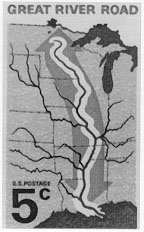
|
October 22
| 1965 | President Lyndon Johnson signs the Highway Beautification Act. He gives the first pen, and a kiss, to Lady Bird Johnson, who started it all by telling her husband he ought to do something about highway beautification. He says, "This bill does not represent all we want, or all we need, or all the national interest requires. But it is a first step. There will be other steps." The President, who had a gall bladder operation 2 weeks earlier, described his trip home on the George Washington Memorial Parkway: "I saw Nature at its purest . . . . And not one foot of it was marred by a single unsightly man-made obstruction--no advertising signs, no junkyards. Well, doctors could prescribe no better medicine for me."
"Beauty belongs to all the people." |
| 1968 | A 3-day Quality Assurance Workshop begins at the Ambassador Hotel in Washington, DC, with 75 State and 50 BPR engineers on hand to discuss statistical quality assurance in highway construction. |
October 23
| 1899 | General Roy Stone resigns and Martin Dodge is appointed Director by President William McKinley. While General Roy Stone served in Puerto Rico during the Spanish-American War, Dodge had been Acting Director from August 1898 to January 1899. Dodge serves until 1905.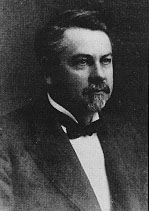
Director Office of Public Road Inquiries |
| 1961 | Mrs. Minnie Lee Harkins, BPR Training Officer, opens a 5-day secretarial development course in the Region 4 Office. Through the use of book reviews, films, discussions, and group participation, Mrs. Harkins gives her students a new concept of the position, "Secretary." They prepare papers on the following subjects: Sincerity, Efficiency, Confidence, Responsibility, Enthusiasm, Tactfulness, Awareness, Resourcefulness, and Your Attitude. |
| 1962 | President John F. Kennedy signs the Federal-Aid Highway Act, which creates the "3C" metropolitan planning process ("continuing, cooperative, and comprehensive") and authorizes funds for relocation advisory assistance. |
| 1968 | Administrator Lowell Bridwell proposes procedures to ensure full public participation in the development of Federal-aid highway projects. He calls for two public hearings, one in advance of route location decisions and one before design approval. He also calls on States to consider the social, economic, and environmental effects of planned projects on the communities through which they pass. |
October 24
| 1918 | A devastating national Spanish flu epidemic takes a grim toll on an OPR/Forest Service project on the Silverton-Durango Highway in southwestern Colorado. OPR Engineer-in-Charge Jo Kingsley, who was stricken last month, dies at Silverton today. John Corlie, OPR's Engineer-in-Charge of the north camp, also comes down with the flu (and died a few days later). As a result, panic grips the 115 laborers on the job. Almost overnight, the camp is practically deserted. Senior Engineer A. E. Palen is on the way to investigate, but the project may have to be postponed.
|
| 1923 | In Olympia, WA, Deputy Chief Engineer L.I. Hewes represents BPR at the dedication of the Pacific Highway in a series of ceremonies marking the hard-surfacing of the highway from Canada to California. After the ceremonies, participants drive to the Interstate Bridge at Vancouver where "Old Man Detour" was hung in effigy amidst the acclaim of thousands of spectators. |
| 1945 | PRA Materials Engineers Harry Rex and C. A. Bergey join C. M. Hartsock of the Raleigh office in North Carolina to inspect sand-asphalt roads that had shown evidence, during a 1943 inspection, of slipping on the underlying pavements. Today, they inspect several roads, including a three-lane section of U.S. 17 (Folkstone to Wilmington). The road had been resurfaced with sand-asphalt in 1942 and carried considerable traffic because of wartime activities at nearby military bases. However, the PRA team found the road in excellent condition.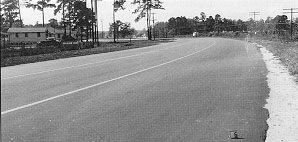
|
| 1963 | The Federal-Aid Highway Amendments, signed today by President John F. Kennedy, makes adjustments and technical corrections, notably revising Interstate standards to provide that design should be such as to accommodate traffic forecast 20 years ahead, rather than the fixed year, 1975, cited in previous legislation. |
| 1965 | Under Public Law 89-205, Federal employees who retire between today and December 30 will receive increased annuity payments (6.1 percent higher in addition to a 2-percent increase in effect for 1965). In BPR, 125 employees retire under the Act (33 from Headquarters, 85 from field offices, and 7 from missions abroad). |
October 25
| 1993 | In a committee meeting during AASHTO's annual meeting in Detroit, MI, former Administrator Ray Barnhart discusses "Fuel Tax Theft--A Government-Sanctioned Industry?" He explains the difficulty of getting people interested in putting up money for the Internal Revenue Service to use in weeding out individuals who are using fraud to avoid paying the gas tax. He estimates an annual loss of $1 billion to $2 billion, and notes that one State working on the issue, Michigan, had recovered about $28 million. |
| 1998 | Administrator Kenneth R. Wykle participates in the groundbreaking ceremony for victims of the bombing of the Arthur P. Murrah Federal Office Building in Oklahoma City on April 19, 1995. The memorial includes a reflecting pool, an interactive museum, and one stone chair for each of the 168 people killed in the blast. Eleven of those chairs will represent FHWA victims. |
October 26
| 1909 | Director Logan Page addresses ARMA's 6th Annual Convention in Columbus, OH, on "The National Government as a Factor in Highway Development." He says, "There is, and I think I am safe in saying this, no money appropriated from the national treasury, which, dollar for dollar, is conducive of more good, and which reaches so large a proportion of our people as the little sum appropriated for [the OPR]."
"While the national government does not give financial assistance in road building, it is furnishing the information and healthy stimulus which is building roads throughout the length and breadth of our land. It is acting as a disseminator of information, whereby the knowledge and experience of expert road builders and trained scientific investigators becomes the common property of all." |
| 1966 | Administrator Rex Whitton issues a memorandum to all employees assuring them that the interests of BPR and its employees are adequately protected in the USDOT Act. "I share the President's pleasure and enthusiasm in the enactment of the legislation and consider it a major step forward in developing a unified and coordinated transportation policy for this great Nation." (See October 18, 1966.) |
October 27
| 1919 | In a letter to all State highway departments, Chief Thomas MacDonald urges them to let contracts as soon as possible in view of the possibility of a rail strike. "Everything possible must be done to facilitate transportation of road materials under these handicaps. Railroad transportation has become too important a factor in the amount of work that can be accomplished to allow it longer to be regarded as incidental. It has become the biggest item in road production." |
| 1961 | Secretary of Commerce Luther H. Hodges administers the oath of office to D. Grant Mickle, the first Deputy Federal Highway Administrator. This position was created by Public Law 87-392, approved by President John Kennedy on October 4, 1961. The Act also abolished the position of Commissioner of Public Roads, last held by Ellis L. Armstrong. Mickle had been with the Automotive Safety Foundation since 1943. |
October 28
| 1992 | In the new Leif Erickson Tunnel, the ribbon is cut and balloons are dropped on the final link of I-35 through Duluth, MN. Mayor Gary Doty and U.S. Representative James Oberstar wield the giant plywood scissors. Oberstar calls the road a "citizens freeway" because of the long public involvement in designing the much acclaimed lake shore portion. Division Administrator Charles Foslien and Lawrence Staron, Chief of the Federal-Aid and Design Division, represent FHWA. On October 9, FHWA announced that the segment had received one of the Agency's biennial "Excellence in Highway Design" awards, noting that the designers "used cut and cover tunnels, architectural design treatments, and extensive landscaping to integrate the freeway into the surrounding urban environment and to create a pleasing driving experience." With the opening of this segment, I-35, a 1,500-mile freeway from Duluth to the Mexican border at Laredo, TX, is also completed.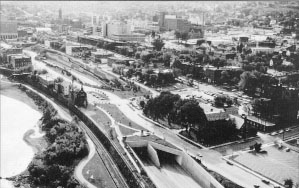
|
October 29
| 1991 | FHWA leadership adopts the vision, mission, values, and goals statement drafted by Agency staff during FHWA 2000. (See January 8, 1991.) The vision begins: "Meet the Nation's need for the safe, efficient and environmentally sound movement of people and goods, and be world renowned in surface transportation expertise and innovation." The statement evolved from a draft prepared by over 130 FHWA employees during a 3-day session in Fredericksburg, VA, and review of the draft by 2,835 employees in a series of 145 "cascading" sessions. The nearly 3,000 pages of data resulting from this process were analyzed by a Consensus Team of employees meeting in Ballston, VA, during 2 weeks in September 1991.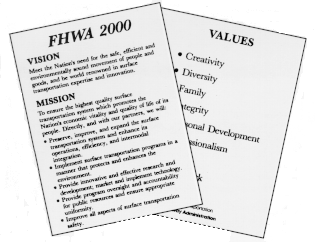
|
October 30
| 1917 | A pathfinding tour to find the best route from Washington, DC, to Atlanta, GA, for the proposed transcontinental Bankhead Highway (Washington, DC, to Los Angeles, CA) leaves the Capitol after ceremonies in the Rotunda. OPRRE's M. O. Eldridge joins John Oliver La Gorce of National Geographic Magazine and A. G. Batchelder of AAA as official "Pathfinders." The highway is named after Senator John Bankhead, a leader in the fight for the Federal Aid Road Act of 1916. (See January 16, 1912.) On April 20, 1919, Eldridge and Batchelder again joined a Bankhead Highway pathfinding tour, leaving Mineral Wells, TX, to identify a route to the Pacific Coast. The tour reached Los Angeles, CA, on May 2, but Eldridge had left the group, apparently at San Diego. One account reported that the "journey through Arizona was through a continuous battle of competitive entertainers . . . . All sought to convince [the pathfinders'] minds by bewildering their stomachs." Batchelder skipped the trip to Los Angeles as well. The account suggested that, "Perhaps he feared he would have to undergo another banquet." |
| 1974 | At the Pier 7 Restaurant in Washington, DC, the FHWA Wives Association holds its first luncheon, featuring Administrator Norbert Tiemann as guest speaker. Susan Evers chairs the Membership Committee and Mary Lamm is President. All wives of current and retired employees of FHWA (and BPR) are eligible for membership. |
| 1984 | The Motor Carrier Safety Act is signed by President Ronald Reagan. The Act directs USDOT to reissue the Federal Motor Carrier Safety Regulations, preempt State safety requirements affecting interstate commerce that are not compatible with Federal regulations, and establish procedures for determining the safety fitness of carriers. |
October 31
| 1957 | Mary S. Austin, transportation economist in the Federal-Aid Division, retires today. She did statistical work for the reports to Congress titled Toll Roads and Free Roads and Interregional Highways, and assisted during designation of Interstate highways in 1947, 1955, and 1957. The News in Public Roads comments, "Over the years she has probably spent more hours working on the system than any other employee." |
| 1977 | In an address to AASHTO's Annual Meeting in Atlantic City, NJ, Administrator William Cox calls for coordination in transportation: "It is our challenge and our opportunity to participate in leading transportation in America into adulthood. I believe we must accomplish this goal by coordination of our modes, our revenues, our planning of our total efforts."
"It is our challenge and our opportunity to participate in leading transportation in America into adulthood. I believe we must accomplish this goal by coordination of our modes, our revenues, our planning of our total efforts." |
Also in October
| 1939 | The New York World's Fair closes for the year. The most popular exhibit proved to be General Motors' Futurama, designer Norman Bel Geddes' vision of the future--1960. Over 5 million visitors had taken a seat in the exhibit's moving armchairs for a 15-minute tour of a "City of Tomorrow," with its buildings linked by pedestrian ways high above street traffic, and beyond, a network of 14-lane superhighways. Some 10,000 scale model cars demonstrated how in 1960, vehicles would move at three prescribed speeds, the movement controlled electronically. Business Week reported last month that, "The federal Bureau of Public Roads is inclined to pooh-pooh the plan (though there are such as believe the bureau might do with a few new ideas)." The Futurama exhibit helps to create public support for the "Interregional Highways" concept that became the Interstate System. PRA's exhibit, "Highways of History," is included in the 1940 New York World's Fair. The sketches and paintings are based on dioramas prepared by BPR artist Carl Rakeman and exhibited around the country. Albert C. Rose of PRA's Visual Education Branch conducted the research for the display. (See March 31, 1976.)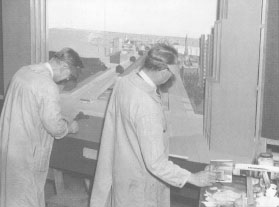
"Who can say what new horizons lie before us if we but have the initiative and imagination to penetrate them--new economic horizons--new social horizons--new horizons in many fields, leading to new benefits for everyone, everywhere." 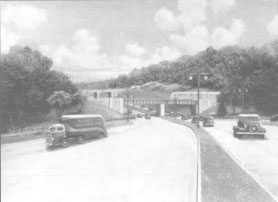
|
| 1970 | Work on a four-lane I-65 bridge across the Tennessee River near Decatur, AL, is to stop at the end of the month, and resume March 1, 1971, because some 65,000 ducks and geese are expected to settle in for the winter at Wheeler National Wildlife Refuge. FHWA, the Department of the Interior, and the Alabama State Highway Department agreed that no construction would proceed while the ducks and geese were settled in the area, and the contractors made their plans accordingly. |
| 1975 | The title of FHWA's Division Engineers is changed to Division Administrators. Administrator Norbert Tiemann explains that the new title is consistent with the titles used at the Federal and Regional levels and, more important, better reflects the nature and scope of the position. "As the role of the Federal Highway Administration has gradually evolved from essentially an engineering function to the much broader responsibility of highway management, so, too, has the assignment of the Division Administrator changed." |
